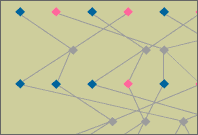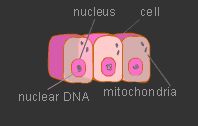|
When it comes to identification with DNA, forensic scientists have
two basic approaches at their disposal. One approach analyzes
nuclear DNA and is useful in identifying someone who is alive or has
died only recently. This is the technique used to incriminate (or
exonerate) suspects of crimes and in paternity testing. It's also
the one used to identify the remains of victims of the September
11th attacks.
The other approach analyzes mitochondrial DNA, or mtDNA. Because
mtDNA tends to survive long after nuclear DNA has disintegrated,
this approach is useful in identifying the remains of persons who
died long ago. It was used, for example, to identify the two crew
members of Bomber 31 who have been identified and, more famously, to
help identify Czar Nicholas II of Russia, who was killed along with
his immediate family in 1918. This is also the technique scholars
have turned to in order to assess how closely related extinct
Neanderthals are to people today*.
What is mtDNA and why is it different? Unlike nuclear DNA, which is
a mixture of genetic material from both parents, mtDNA is passed on,
with no change, from mother to offspring. The father's mtDNA, on the
other hand, is destined to die off; no trace of its genes will pass
on to subsequent generations (unless a woman who inherited the same
mtDNA—his sister, for example—has children of her own).
Outside the nucleus, but still within the cell, lie anywhere from
200 to 2,000 mitochondria. Mitochondria are tiny structures that
help cells in a number of ways, including producing the energy that
cells need. Every mitochondrion includes an identical loop of DNA
about 16,000 base pairs long. By contrast, each cell contains only a
single set of nuclear DNA (46 chromosomes), which is made up of
3,000,000,000 base pairs. Whenever an egg cell is fertilized,
nuclear chromosomes from a sperm cell enter the egg and, together
with the egg's nuclear DNA, form the DNA for the new individual. The
mtDNA from the sperm cell, on the other hand, is left behind,
outside of the egg cell. This is why only the mother's mtDNA carries
on to subsequent generations.
Since mtDNA is passed on only through maternal lines, forensic
scientists can use it to assist with the identification of someone
who died long ago by matching that person's mtDNA to any ancestor or
descendant on that line. This wouldn't be possible, however, if
mtDNA wasn't as long lived as it is. Because there are so many more
copies of mtDNA within the cells of our bodies, mtDNA tends to be
around, even in bone fragments, long after nuclear DNA has fallen
apart.
The following interactive feature shows who within a family tree
shares the same mtDNA. It also shows how the mtDNA for many
descendants can all be traced back to one common ancestor while
their nuclear DNA can be a mixture of DNA from many ancestors.
|

|
|
Flash is a plug-in that allows for increased
interactivity. If you can see the animated boxes at
left, the plugin is already installed. If you do not see
the boxes, you can
install the Flash plugin.
|
|

|
In reproduction, the nuclear DNA of one parent mixes
with the nuclear DNA of the other. MtDNA, on the other
hand, passes on from mother to offspring unaltered.
|
|
|

